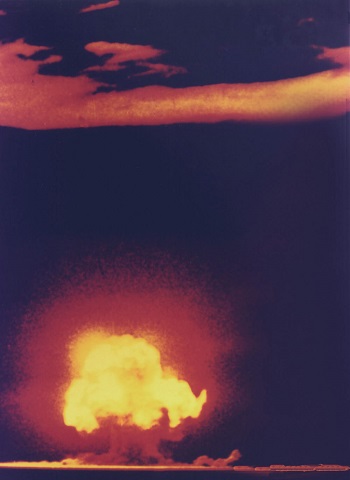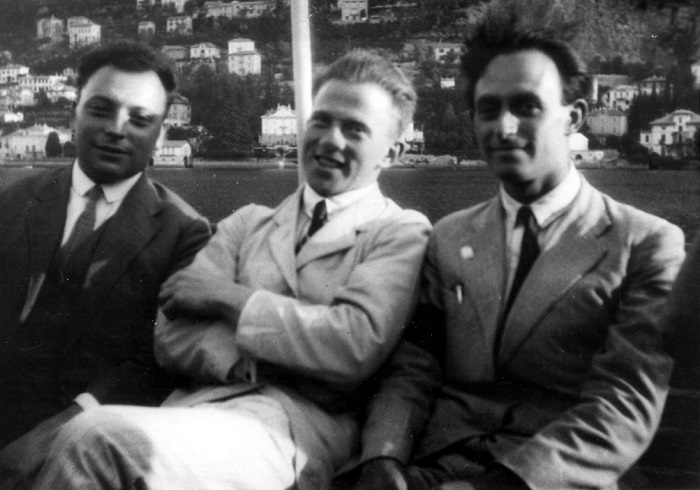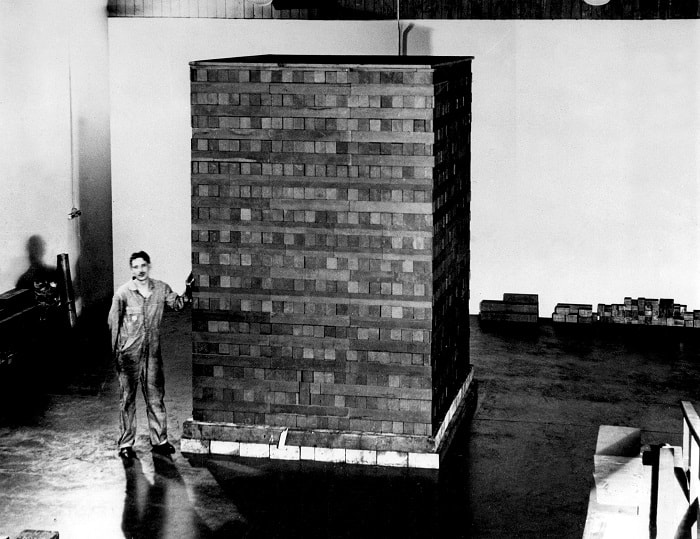Among the 20th century physicists, there were people more creative than Enrico Fermi; one or two of them thought more deeply, and a few were more skilled in mathematics. But Enrico Fermi was the best problem solver of them, with his amazing ability to see the essence of any physics problem. He was also the last person to reach the highest level in both theoretical and experimental fields.
The invention of the atomic bomb
His reaction to the explosion test of the first atomic bomb shows these qualities. Fermi was the scientist in charge of the physical concepts developed at the Los Alamos National Laboratory in New Mexico, which served as the research and design center for the nuclear weapon development program known as the “Manhattan Project“. He played an important role both in these concepts that led to the making of the atomic bomb and also in the construction of the actual bomb. Many of those at Los Alamos saw him as a prophet to be consulted in any difficult problem of theory, experiment, or computation. Nevertheless, he never made an engraved quote to honor the memories of the test explosion of the atomic bomb on July 16, 1945. However, there is an interesting story.
J. Robert Oppenheimer’s immediate response to this event as director of the Manhattan Project is the most well-known. When he saw the explosion light up the sky, he remembered a line from the Hindu inscription Bhagavad Gita. Vishnu said to the Princess: “Now I am become Death, the destroyer of worlds.” On the other hand, the head of the test, Kenneth Bainbridge, summarized the same event differently: “Now, we are all sons of bitches.” While those present on the test side were feeling emotions ranging from fear to pride, the always pragmatic Fermi was seen breaking down a sheet of paper to find a quick and simple way to measure the impact of the explosion.
When the shock wave reached his location after 40 seconds, it blew the pieces around. He calmly observed how far the pieces flew, then referred to a simple chart he had previously prepared, took out the spreadsheet, and made his prediction about the size of the atomic explosion. Fermi’s ability to calculate the dimensions of any physical phenomenon was legendary, and as the detailed measurements show later, this was no exception.
Who was Enrico Fermi?

Enrico Fermi was born on September 29, 1901, in Rome and grew up in an ordinary family. His father worked on the state railways; his mother was a teacher. Fermi’s extraordinary abilities were quickly noticed, and he was awarded a scholarship to study at the Scuola Normale Superiore at the elite university of Italy, Pisa. Here, he quickly overshadowed not only other students but also teachers. At that time, Italy was relatively weak in physics. This means that Fermi was a self-taught student. He has made it his style to try to find a simple solution to a problem by figuring out what the main points are.
This approach was opposed to the dominant German school of that time, which was based heavily on mathematics. After graduation, Fermi quickly solved many important problems in theoretical physics, one of which was the subject of statistical mechanics, which incorporated the approaches of the new quantum mechanics. This success attracted the attention of physics professor Orso Corbino in Rome. He was a much older man than Fermi, who was looking for the person of his dreams to run the world-class physics institute.
Corbino, a politically strong man, saw his dreams come true in Fermi. In an unprecedented fashion in Italy, Fermi helped him join the theoretical physics chair in Rome when he was 26 years old.
Enrico Fermi went far beyond Corbino’s dreams by attracting visitors from all over Europe and developing young Italian talents. Fermi’s best-known contribution to theoretical physics was made in 1934, when he introduced the theory of weak interactions in particle physics. It has been known for several years that nuclear decays that release electrons do not seem to comply with the energy conservation law. This principle was an important enigma as it was the cornerstone of physics at the time. Niels Bohr argued that conservation might not be so absolute. On the other hand, Wolfgang Pauli thought that it was absolute, and the lost energy was carried by a new particle called the neutrino. But how?
Theory and experiments

In 1934, Fermi showed how this phenomenon could occur. He called Pauli’s unknown particle the neutrino and suggested the existence of a new kind of interaction in which a neutron decays and dissociates into protons, electrons, and neutrinos. He showed the possible paths the interaction could take, calculated its size, and explained the results. At a time when the only two known forces were gravity and electromagnetism, this was a revolutionary concept; it is still seen as a milestone in physics.
While continuing to work as a theorist, he formed a tightly connected group of experiments, most of whom will continue on their way to distinguished careers. The original group of Edoardo Amaldi, Bruno Pontecorvo, Franco Rasetti, and Emilio Segre took part in the most important experimental initiative of Fermi. Until the early 1930s, scattering from nuclear targets was done by bombarding the rays of alpha particles (i.e., helium nuclei) from radioactive decay using a technique led by Ernest Rutherford.
But in 1932, James Chadwick’s discovery of the neutron in Cambridge offered a new opportunity for bombardment. Focusing on the neutron beam was more difficult, but the fact that the electrical charges were neutral meant that neutrons would not be pushed away in the nuclear bombardment. Therefore, they were more likely to reach the target. Fermi now had an important insight.
The possibility of a nuclear transformation was expected to increase with the increasing energy of the bombarding neutron, but he realized that the opposite was true. The slower the incoming neutrons are, the more time it takes for them to pass through the target nucleus, and the greater the chances of a reaction. This new system has led to several important discoveries, some by his group and some by other scientists. One of them was the invention of nuclear fission in 1938.
Enrico Fermi was awarded the Nobel Prize in Physics for this work in 1938 and went directly from Sweden to the USA. The decision to migrate was wise, as his wife was Jewish and brutal race laws were introduced in Italy under Mussolini. The departure of Fermi determined the end of an era in Italian physics, but now this area has taken its place in the mainstream of the country, even though it lost its biggest practitioner.
Enrico Fermi and the world’s first nuclear reactor

Enrico Fermi’s neutrino research was increasingly turning toward military purposes, but he continued it in his new homeland. He oversaw the construction of the first nuclear reactor at the University of Chicago in 1942, and he was still working when criticality — the point at which a reactor can sustain a fission chain reaction on its own — was achieved. He then transferred his work to Los Alamos, but at the end of the war, he returned to the University of Chicago and performed activities in other fields, such as astrophysics. He also became the leading name in emerging high-energy physics.
He continued his legendary career as both a theorist and an experimental worker. He attracted many talented young American physicists to Chicago. In 1954, Fermi was diagnosed with stomach cancer while he was at the summit of his power and died shortly after the exploratory surgery, which showed how the cancer had spread. His death caused sadness all over the world. The largest high-energy facility in the USA was named Fermi National Accelerator Laboratory (Fermilab). More importantly, all the particles with a half-odd integer spin (neutron, proton, electron, and neutrino) are now called fermion particles.
Bibliography:
- Amaldi, Edoardo (2001). “Commemoration of the Academy Fellow Enrico Fermi”. In Bernardini, C.; Bonolis, Luisa (eds.). Enrico Fermi: His Work and Legacy. Bologna: Società Italiana di Fisica: Springer. pp. 23–35. ISBN 978-88-7438-015-2. OCLC 56686431.
- Amaldi, Ugo (2001). “Nuclear Physics from the Nineteen Thirties to the Present Day”. In Bernardini, C.; Bonolis, Luisa (eds.). Enrico Fermi: His Work and Legacy. Bologna: Società Italiana di Fisica: Springer. pp. 151–176. ISBN 978-88-7438-015-2. OCLC 56686431.
- Hewlett, Richard G.; Anderson, Oscar E. (1962). The New World, 1939–1946 (PDF). University Park: Pennsylvania State University Press. ISBN 978-0-520-07186-5. OCLC 637004643.
- Hewlett, Richard G.; Duncan, Francis (1969). Atomic Shield, 1947–1952. A History of the United States Atomic Energy Commission. University Park: Pennsylvania State University Press. ISBN 978-0-520-07187-2. OCLC 3717478.


